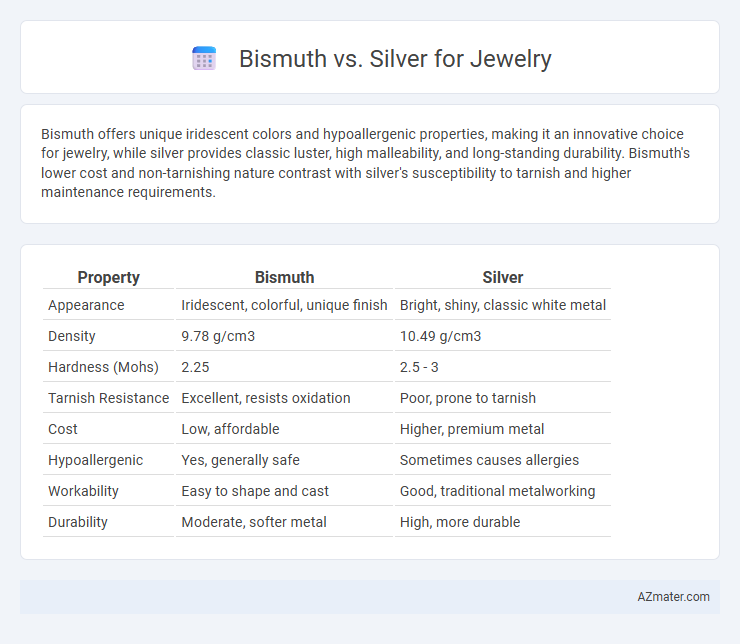Bismuth offers unique iridescent colors and hypoallergenic properties, making it an innovative choice for jewelry, while silver provides classic luster, high malleability, and long-standing durability. Bismuth's lower cost and non-tarnishing nature contrast with silver's susceptibility to tarnish and higher maintenance requirements.
Table of Comparison
| Property | Bismuth | Silver |
|---|---|---|
| Appearance | Iridescent, colorful, unique finish | Bright, shiny, classic white metal |
| Density | 9.78 g/cm3 | 10.49 g/cm3 |
| Hardness (Mohs) | 2.25 | 2.5 - 3 |
| Tarnish Resistance | Excellent, resists oxidation | Poor, prone to tarnish |
| Cost | Low, affordable | Higher, premium metal |
| Hypoallergenic | Yes, generally safe | Sometimes causes allergies |
| Workability | Easy to shape and cast | Good, traditional metalworking |
| Durability | Moderate, softer metal | High, more durable |
Introduction to Bismuth and Silver in Jewelry
Bismuth in jewelry is prized for its unique iridescent colors and non-toxic, hypoallergenic properties, often appearing as geometric, crystalline structures that create eye-catching designs. Silver, a traditional precious metal, is favored for its classic lustrous finish, durability, and ease of crafting into intricate patterns, making it a staple in fine and everyday jewelry. Both metals offer distinct aesthetic qualities and functional benefits, with bismuth appealing to avant-garde styles and silver maintaining timeless elegance.
Physical Properties: Bismuth vs Silver
Bismuth exhibits a low melting point of 271degC and a high density of 9.78 g/cm3, making it heavier and more brittle compared to silver. Silver boasts a higher melting point of 961.8degC, excellent ductility, and a density of 10.49 g/cm3, contributing to its superior durability and malleability in jewelry applications. While bismuth's unique iridescent colors offer distinct visual appeal, silver's physical properties ensure better longevity and resistance to wear for fine jewelry.
Aesthetic Appeal: Color and Luster Comparison
Bismuth jewelry boasts a unique iridescent color palette with vibrant, shifting hues ranging from blues and greens to purples, creating a captivating visual effect unlike traditional metals. In contrast, silver offers a classic, bright white luster with a smooth, reflective surface that pairs well with various gemstones and styles. While bismuth's crystalline structure provides a textured, holographic aesthetic, silver maintains a timeless shine that enhances elegance and versatility in jewelry design.
Hypoallergenic Qualities and Skin Sensitivity
Bismuth is increasingly favored in jewelry for its hypoallergenic properties, causing minimal skin irritation compared to silver, which can sometimes trigger allergies due to its alloy components like nickel. Silver, especially sterling silver, often requires careful consideration for sensitive skin, as tarnishing and metal reactions may lead to contact dermatitis. Choosing bismuth jewelry offers a safer alternative for wearers with sensitive skin, reducing the risk of allergic reactions and promoting comfortable, long-term wear.
Durability and Wear Resistance
Bismuth jewelry exhibits lower durability and wear resistance compared to silver, as it is a softer and more brittle metal prone to chipping and deformation. Silver, particularly sterling silver with its 92.5% purity, offers superior hardness and resilience against scratches and daily wear, making it a preferred choice for long-lasting jewelry. While bismuth's unique iridescent appearance attracts niche markets, silver remains the standard for durable, wear-resistant jewelry pieces.
Cost and Affordability Analysis
Bismuth offers a significantly lower cost alternative to silver in jewelry, with prices often less than one-tenth per gram, making it highly affordable for budget-conscious consumers. Silver, valued for its durability and traditional appeal, commands higher market prices typically governed by global commodity rates and purity standards such as 925 sterling silver. When factoring in long-term investment and resale value, silver retains greater worth, whereas bismuth serves as an economical choice for unique, artistic pieces without substantial financial commitment.
Crafting Techniques: Workability and Malleability
Bismuth exhibits moderate workability with a unique crystalline structure that easily forms intricate, geometric patterns, making it ideal for artistic jewelry designs requiring precise, delicate detailing. Silver is highly malleable and ductile, allowing jewelers to shape and mold it extensively using traditional techniques like hammering, engraving, and soldering for versatile, durable pieces. The contrast in malleability impacts crafting methods: bismuth requires careful cooling to preserve its aesthetic crystals, while silver supports extensive mechanical manipulation for complex forms.
Tarnish Resistance and Maintenance
Bismuth jewelry offers superior tarnish resistance compared to silver due to its stable oxide layer that prevents corrosion and discoloration over time. Silver, while popular for its shine, is prone to tarnishing when exposed to sulfur compounds and requires regular polishing and maintenance to retain its luster. Choosing bismuth reduces the need for frequent cleaning, making it a low-maintenance option for jewelry wearers concerned with durability and appearance.
Environmental Impact and Sustainability
Bismuth offers a significantly lower environmental impact than silver due to its non-toxic properties and the fact that it is often a byproduct of mining other metals, reducing the need for dedicated extraction efforts. Silver mining is associated with greater ecological disruption, higher energy consumption, and the release of harmful pollutants such as cyanide and heavy metals into surrounding ecosystems. Choosing bismuth for jewelry supports sustainability by minimizing soil and water contamination and promoting the use of recycled and less harmful materials.
Choosing the Right Metal for Your Jewelry
When choosing between bismuth and silver for jewelry, consider durability, appearance, and hypoallergenic properties. Silver offers a classic, bright luster, excellent malleability, and is widely favored for its timeless appeal, though it may tarnish over time. Bismuth provides unique iridescent colors and is non-toxic with low reactivity, making it a distinctive choice for artistic, lightweight pieces less prone to skin irritation.

Infographic: Bismuth vs Silver for Jewelry
 azmater.com
azmater.com